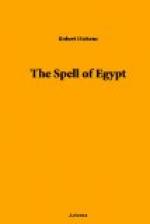And must you not pray, too, when you enter certain temples where once strange gods were worshipped in whom no man now believes?
There is one temple on the Nile which seems to embrace in its arms all the worship of the past; to be full of prayers and solemn praises; to be the holder, the noble keeper, of the sacred longings, of the unearthly desires and aspirations, of the dead. It is the temple of Edfu. From all the other temples it stands apart. It is the temple of inward flame, of the secret soul of man; of that mystery within us that is exquisitely sensitive, and exquisitely alive; that has longings it cannot tell, and sorrows it dare not whisper, and loves it can only love.
To Horus it was dedicated—hawk-headed Horus—the son of Isis and Osiris, who was crowned with many crowns, who was the young Apollo of the old Egyptian world. But though I know this, I am never able to associate Edfu with Horus, that child wearing the side-lock—when he is not hawk-headed in his solar aspect—that boy with his finger in his mouth, that youth who fought against Set, murderer of his father.
Edfu, in its solemn beauty, in its perfection of form, seems to me to pass into a region altogether beyond identification with the worship of any special deity, with particular attributes, perhaps with particular limitations; one who can be graven upon walls, and upon architraves and pillars painted in brilliant colors; one who can personally pursue a criminal, like some policeman in the street; even one who can rise upon the world in the visible glory of the sun. To me, Edfu must always represent the world-worship of “the Hidden One”; not Amun, god of the dead, fused with Ra, with Amsu, or with Khnum: but that other “Hidden One,” who is God of the happy hunting-ground of savages, with whom the Buddhist strives to merge his strange serenity of soul; who is adored in the “Holy Places” by the Moslem, and lifted mystically above the heads of kneeling Catholics in cathedrals dim with incense, and merrily praised with the banjo and the trumpet in the streets of black English cities; who is asked for children by longing women, and for new dolls by lisping babes; whom the atheist denies in the day, and fears in the darkness of night; who is on the lips alike of priest and blasphemer, and in the soul of all human life.
Edfu stands alone, not near any other temple. It is not pagan; it is not Christian: it is a place in which to worship according to the dictates of your heart.
Edfu stands alone on the bank of the Nile between Luxor and Assuan. It is not very far from El-Kab, once the capital of Upper Egypt, and it is about two thousand years old. The building of it took over one hundred and eighty years, and it is the most perfectly preserved temple to-day of all the antique world. It is huge and it is splendid. It has towers one hundred and twelve feet high, a propylon two hundred and fifty-two feet broad, and walls four hundred and fifty feet long. Begun in the reign of Ptolemy III., it was completed only fifty-seven years before the birth of Christ.




